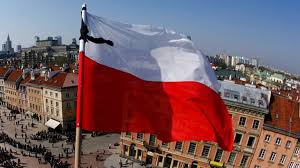
Poland’s stark assertion that it is “closest to open conflict since World War Two” after a wave of drone incursions has pushed a longstanding historical anxiety back into the centre of diplomatic debate. Warsaw’s alarm reflects not only worries about immediate border violations but also the deeper imprint of Poland’s 20th-century experience and the strategic dynamics created by NATO’s post-Cold War expansion eastwards — developments Moscow regularly cites as justification for a more aggressive posture.
A sharp warning and the Article 4 ask
Poland’s government publicly framed recent airspace breaches and the recovery of drone debris as an escalation that crosses a dangerous line. By invoking NATO’s consultation mechanism under Article 4, Warsaw signalled it views the incidents as a collective security concern that warrants allied deliberation. Article 4 compels consultations — not automatic military action — but its activation tests alliance unity and sets the diplomatic clock ticking. For a country on NATO’s eastern flank, repeated incursions are not merely tactical incidents: they raise questions about deterrence, rules of engagement and the protection of civilian infrastructure near volatile borders.
Officials emphasised that while there was no intent to precipitate a wider war, the volume and persistence of incursions had transformed routine air-defence responses into a political moment. The invocation of Article 4 seeks not just immediate reassurance but a formal allied conversation about steps to prevent further breaches and to sharpen collective defenses along NATO’s frontier.
Why Poland uses the language of existential danger
Poland’s rhetorical intensity is rooted in memory as much as in immediate security calculations. The historical trauma of being invaded in 1939 by Germany and, days later, by the Soviet Union — an event that ushered in occupation, mass loss of life and decades of external domination — informs contemporary threat perceptions. For many Poles, violations of sovereignty and territorial probes rekindle the spectre of overwriting national independence, making even limited kinetic events feel existential.
This historical lens explains why Warsaw treats incursions with amplified severity: the collective memory of devastation, occupation and postwar Soviet control creates a low tolerance for perceived encroachments. Political leaders therefore frame breaches in stark terms to mobilise domestic support, to press allies for concrete protection, and to send a deterrent signal to any actor that might test Poland’s boundaries.
Poland’s experience in World War Two was uniquely brutal and formative. It was the first country invaded in the European theatre, and its population endured both Nazi occupation and Soviet repression. Cities were destroyed in uprisings that were met with harsh reprisals; the nation suffered enormous civilian casualties and the genocide of large parts of its Jewish population on Polish soil. After the war, Poland’s political fate was recast under Soviet influence, a period that left political institutions and public memory scarred.
These layers of victimhood, resistance and imposed subordination have shaped Poland’s modern political identity: sovereignty and the ability to defend national territory are deeply embedded concerns. That explains why Polish officials often speak about security in absolute terms and why actions perceived as threats — even when technically limited — are treated as possible preludes to something far graver.
NATO’s eastward expansion: the map changed after the Cold War
The strategic landscape that now frames Poland’s anxieties was reshaped decisively after 1991, when former Warsaw Pact and Soviet-adjacent states chose to anchor their security within Western institutions. NATO’s enlargements came in sequential waves: the alliance admitted a first set of Central European members in the late 1990s and expanded further in the early 2000s to include the Baltic states and several Central and Eastern European countries. Later accessions and partnerships extended NATO’s reach ever closer to Russia’s borders.
From the perspective of the new members, enlargement was a sovereign choice to lock in democratic and security gains after decades of authoritarian domination or Soviet tutelage. For capitals like Warsaw, NATO membership offered a security guarantee against the kind of external interference that had cost them so dearly in the 20th century. The presence of NATO forces, exercises and defensive infrastructure on the eastern flank is therefore seen in these capitals as a stabilising shield.
Why Russia perceives enlargement as a threat
In contrast, Russia’s leaders interpret NATO’s eastward steps through a different prism: one of strategic depth, historic buffers, and what they view as broken informal assurances at the end of the Cold War. Kremlin officials argue that successive waves of enlargement eroded Russia’s traditional defensive perimeter and brought a powerful military alliance up against its western approaches. This perception feeds a narrative of encirclement and vulnerability that Russian policymakers say justifies a more assertive posture in their neighbourhood.
The collision of these narratives — sovereign states seeking security through NATO, and Moscow seeing those same moves as hostile encroachment — helps explain why incidents along NATO’s eastern edge rapidly acquire outsized significance. When weapons, drones, or missiles cross borders, the incident is not viewed in isolation: it becomes part of a wider story about alliance cohesion, deterrence credibility and whether red lines will be respected.
Poland’s formal consultation request will focus allied attention on practical security questions: whether to boost air patrols, adjust rules of engagement, increase missile-defence assets, or expand intelligence-sharing among frontline states. The consultations will also be a test of allied political will to manage escalation while avoiding inadvertent confrontation.
Observers will monitor several indicators: the frequency of further airspace violations, any operational shifts in NATO deployments on the eastern flank, diplomatic exchanges with Moscow, and domestic political reaction in Poland and neighbouring states. The interplay of historical memory, alliance assurances and contemporary warfare dynamics means even limited incidents can ripple into wider strategic consequences.
Poland’s invocation of the language of near-conflict is therefore both an expression of immediate alarm and a call to allies to translate solidarity into tangible deterrent measures. Whether the Article 4 consultations produce de-escalatory mechanisms, firm defensive steps, or merely a public reaffirmation of unity will shape how Warsaw and its neighbours perceive security in a still-unstable regional order.
(Source:www.businesstoday.in)
A sharp warning and the Article 4 ask
Poland’s government publicly framed recent airspace breaches and the recovery of drone debris as an escalation that crosses a dangerous line. By invoking NATO’s consultation mechanism under Article 4, Warsaw signalled it views the incidents as a collective security concern that warrants allied deliberation. Article 4 compels consultations — not automatic military action — but its activation tests alliance unity and sets the diplomatic clock ticking. For a country on NATO’s eastern flank, repeated incursions are not merely tactical incidents: they raise questions about deterrence, rules of engagement and the protection of civilian infrastructure near volatile borders.
Officials emphasised that while there was no intent to precipitate a wider war, the volume and persistence of incursions had transformed routine air-defence responses into a political moment. The invocation of Article 4 seeks not just immediate reassurance but a formal allied conversation about steps to prevent further breaches and to sharpen collective defenses along NATO’s frontier.
Why Poland uses the language of existential danger
Poland’s rhetorical intensity is rooted in memory as much as in immediate security calculations. The historical trauma of being invaded in 1939 by Germany and, days later, by the Soviet Union — an event that ushered in occupation, mass loss of life and decades of external domination — informs contemporary threat perceptions. For many Poles, violations of sovereignty and territorial probes rekindle the spectre of overwriting national independence, making even limited kinetic events feel existential.
This historical lens explains why Warsaw treats incursions with amplified severity: the collective memory of devastation, occupation and postwar Soviet control creates a low tolerance for perceived encroachments. Political leaders therefore frame breaches in stark terms to mobilise domestic support, to press allies for concrete protection, and to send a deterrent signal to any actor that might test Poland’s boundaries.
Poland’s experience in World War Two was uniquely brutal and formative. It was the first country invaded in the European theatre, and its population endured both Nazi occupation and Soviet repression. Cities were destroyed in uprisings that were met with harsh reprisals; the nation suffered enormous civilian casualties and the genocide of large parts of its Jewish population on Polish soil. After the war, Poland’s political fate was recast under Soviet influence, a period that left political institutions and public memory scarred.
These layers of victimhood, resistance and imposed subordination have shaped Poland’s modern political identity: sovereignty and the ability to defend national territory are deeply embedded concerns. That explains why Polish officials often speak about security in absolute terms and why actions perceived as threats — even when technically limited — are treated as possible preludes to something far graver.
NATO’s eastward expansion: the map changed after the Cold War
The strategic landscape that now frames Poland’s anxieties was reshaped decisively after 1991, when former Warsaw Pact and Soviet-adjacent states chose to anchor their security within Western institutions. NATO’s enlargements came in sequential waves: the alliance admitted a first set of Central European members in the late 1990s and expanded further in the early 2000s to include the Baltic states and several Central and Eastern European countries. Later accessions and partnerships extended NATO’s reach ever closer to Russia’s borders.
From the perspective of the new members, enlargement was a sovereign choice to lock in democratic and security gains after decades of authoritarian domination or Soviet tutelage. For capitals like Warsaw, NATO membership offered a security guarantee against the kind of external interference that had cost them so dearly in the 20th century. The presence of NATO forces, exercises and defensive infrastructure on the eastern flank is therefore seen in these capitals as a stabilising shield.
Why Russia perceives enlargement as a threat
In contrast, Russia’s leaders interpret NATO’s eastward steps through a different prism: one of strategic depth, historic buffers, and what they view as broken informal assurances at the end of the Cold War. Kremlin officials argue that successive waves of enlargement eroded Russia’s traditional defensive perimeter and brought a powerful military alliance up against its western approaches. This perception feeds a narrative of encirclement and vulnerability that Russian policymakers say justifies a more assertive posture in their neighbourhood.
The collision of these narratives — sovereign states seeking security through NATO, and Moscow seeing those same moves as hostile encroachment — helps explain why incidents along NATO’s eastern edge rapidly acquire outsized significance. When weapons, drones, or missiles cross borders, the incident is not viewed in isolation: it becomes part of a wider story about alliance cohesion, deterrence credibility and whether red lines will be respected.
Poland’s formal consultation request will focus allied attention on practical security questions: whether to boost air patrols, adjust rules of engagement, increase missile-defence assets, or expand intelligence-sharing among frontline states. The consultations will also be a test of allied political will to manage escalation while avoiding inadvertent confrontation.
Observers will monitor several indicators: the frequency of further airspace violations, any operational shifts in NATO deployments on the eastern flank, diplomatic exchanges with Moscow, and domestic political reaction in Poland and neighbouring states. The interplay of historical memory, alliance assurances and contemporary warfare dynamics means even limited incidents can ripple into wider strategic consequences.
Poland’s invocation of the language of near-conflict is therefore both an expression of immediate alarm and a call to allies to translate solidarity into tangible deterrent measures. Whether the Article 4 consultations produce de-escalatory mechanisms, firm defensive steps, or merely a public reaffirmation of unity will shape how Warsaw and its neighbours perceive security in a still-unstable regional order.
(Source:www.businesstoday.in)





